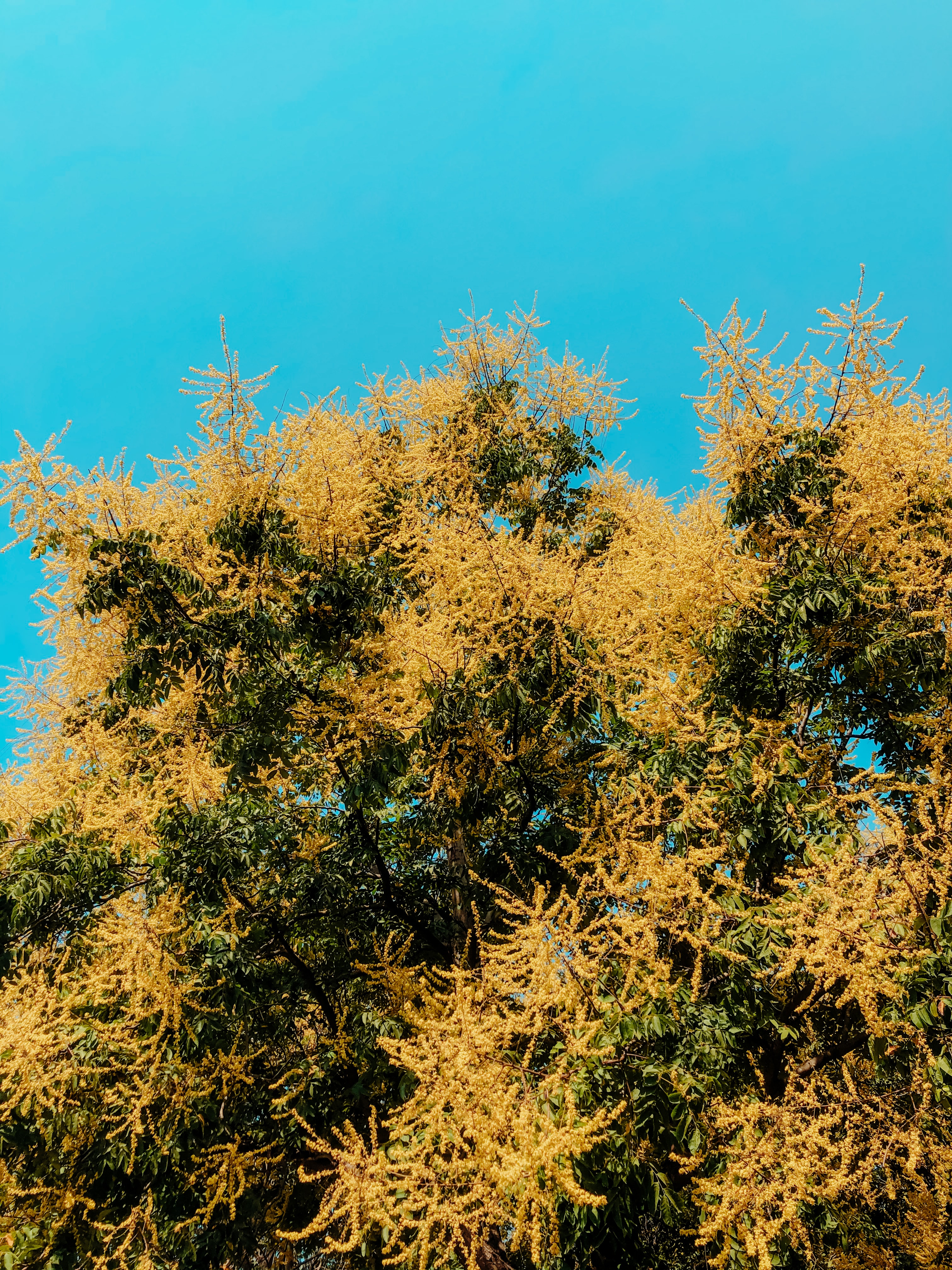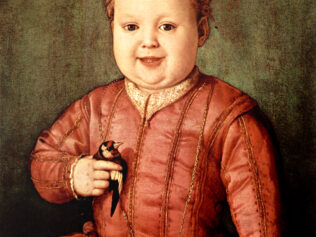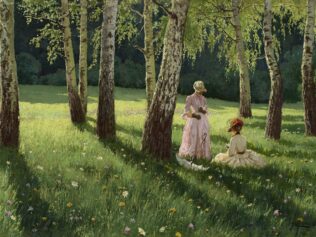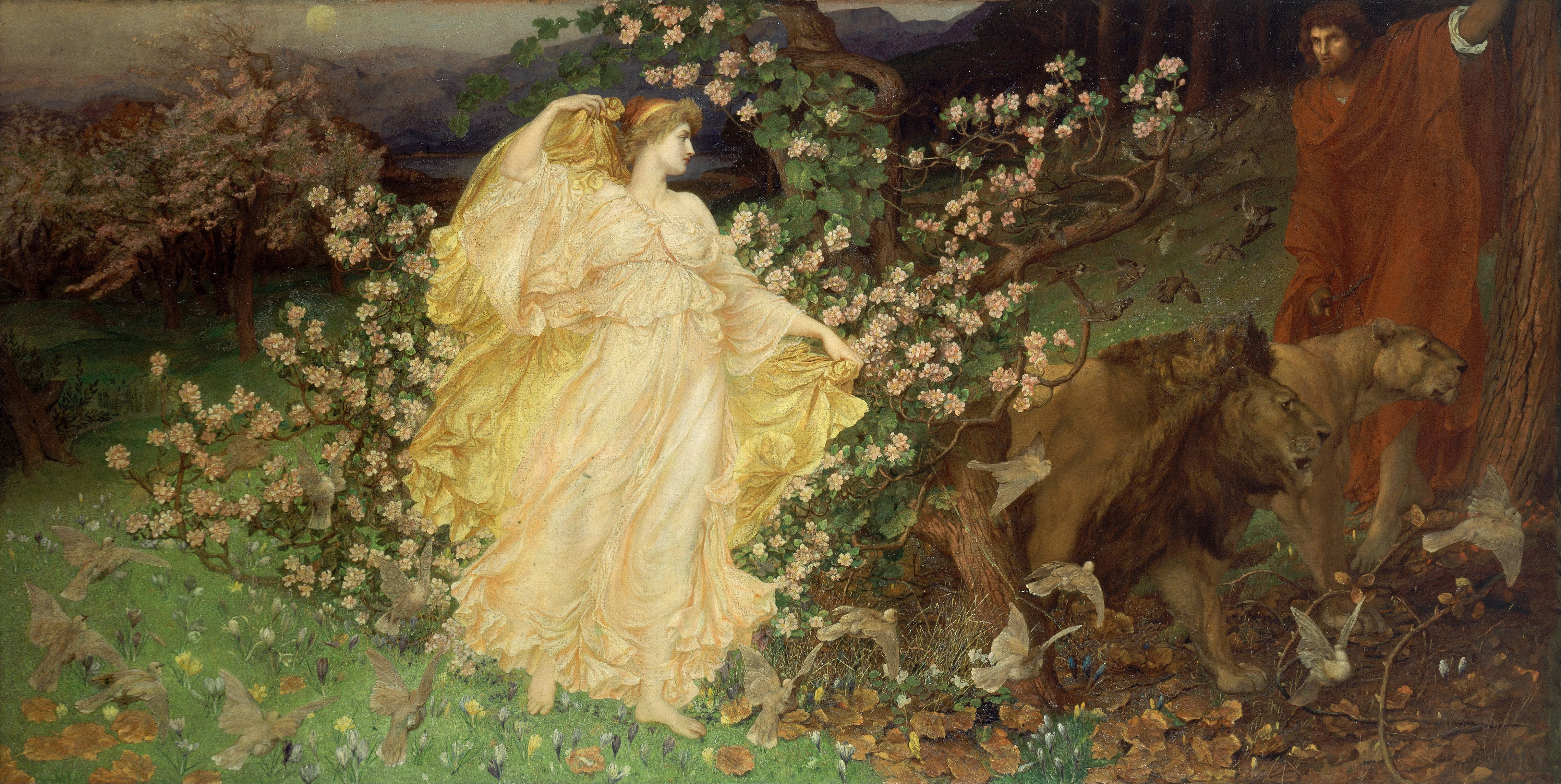
In China, the divine tree was the pine. The fig tree brought enlightenment to Buddhists. Olympian deities shared out oaks, cypresses and poplars among themselves. Since time immemorial, people have regarded greenery as a sort of shrine: home to cults, symbols and taboos of all kind.
In late 2020, the University of Cambridge admitted that Charles Darwin’s notebooks were stolen from the university’s library. The 1837 notebook included an invaluable drawing: a diagram which Darwin called ‘The Tree of Life’. The complex graph depicts evolutionary interdependencies between species, just as a family tree represents blood relationships between people. Darwin found the arboreal metaphor so apposite that he used it again, 22 years later, in his On the Origin of Species. The book includes a dramatic image of a tree tousled by conflicting gusts, its branches and sprouts vying for light and water:
As buds give rise by growth to fresh buds and these, if vigorous, branch out and overtop on all sides many a feebler branch, so by generation I believe it has been with the great Tree of Life, which fills with its dead and broken branches the crust of the earth, and covers the surface with its ever branching and beautiful ramifications.
Darwin used an unobvious, albeit ancient metaphor. The Tree of Life grew in the garden of Eden, and so it symbolically opens the Old Testament. According to a prophesy in the Book of Revelation, the final part of the Christian Bible, victorious Christians will eat the fruit of the Tree of Life. Darwin, who came from a Unitarian family, could quote from Milton’s Paradise Lost at random [and he most likely knew this fragment]:
Out of the fertile ground he caused to grow
All trees the noblest kind for sight, smell, taste;
And all amid them stood the Tree of Life,
High, eminent, blooming ambrosial fruit
Of vegetable gold […]
(IV / 216 – 220)
A friend of Darwin’s, the Scottish poet Thomas Carlyle, cited the Scandinavian myth of the Yggdrasil. This enormous tree (sometimes identified as an ash tree or an evergreen species) hosts three worlds,
with a squirrel carrying missives between them. One of the worlds is inhabited by people, another by giants, and the third is the domain of Hel, the ruler of the underworld. Three goddesses of fate live near the tree trunk, and different animals have their homes among the leaves and branches.
150 years later, evolutionist Richard Dawkins observed:
It is no accident that we see green almost wherever we look. It is no accident that we find ourselves perched on one tiny twig in the midst of the blossoming and flourishing tree of life; no accident that we are surrounded by millions of other species, eating, growing, rotting, swimming, walking, flying, burrowing, stalking, chasing, fleeing, outpacing, outwitting. Without green plants to outnumber us at least ten to one there would be no energy to power us.
In the shadow of the holy tree
Since time immemorial, trees were the object of cult and subject to taboo. Offerings were brought to trees; and, depending on the epoch and region, different species were regarded as the tree of life. In Mesopotamia, the holy tree resembled a date palm. In Phoenicia, cedrus trees were known as ‘the home of the deity’. In ancient China, the pine was granted divine status: an evergreen, frost-resistant tree, it was a symbol of perseverance and strength of character. Buddhists worship the pagoda fig tree, known as the Bodhi tree: it was in the shade of that tree that Buddha experienced illumination. Olympian deities were assigned their own trees: Zeus had his oaks at Dodone, Athene had the olive tree, Apollo, the cypress tree and Poseidon, the poplar. In the Hebrew tradition, revelations and conversions occurred in the shade of tamarind, pistachio, oak and cypress trees. Living trees, entire groves and even dead trunks were worshipped.
The image of an enormous tree, whose fruit grant immortality and branches reach the sky, stems from prehistoric Iran’s religious beliefs, combining Semitic and Indo-Aryan myths. A similar story (with numerous variations) features in all ancient civilizations.
In the Mesopotamian tradition, the tree of life (consisting of a trunk, a palmette crown and symmetrical, horizontal branches) often appears alongside royal personages, and features in architectural details, or as a decorative element in clothing or jewellery. Animals are reared up on their hind legs on both sides of the tree: gazelles, deer and goats, symbols of fertility and potency. This motif recurs nearly 200 times in low reliefs decorating the Ashurnasirpal II palace at Nimrud.
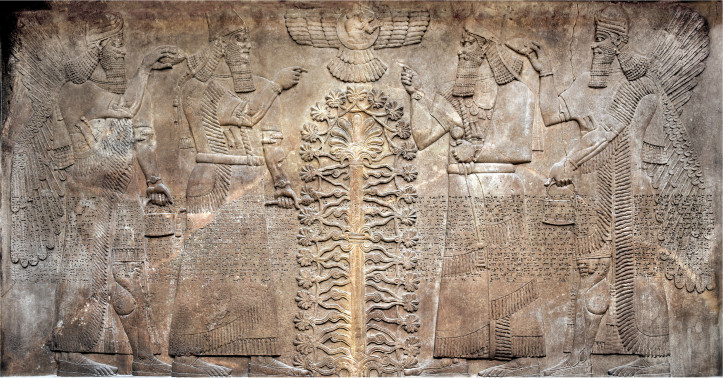
In Egypt, the cult of the tree lived on through millennia: the only things that changed were the mythological framework and… the tree species. The evergreen Mimusops schimperi was worshipped in the Old Kingdom. The fruit of that tree resembled a pear and stood for the holy heart of Horus; eating this fruit granted access to eternal, divine knowledge. But when this tree disappeared from the Egyptian landscape as a result of climate change, the sycamore (nehet) began to be worshipped, becoming Hathor’s holy tree. It was believed the dead who were buried in coffins carved from sycamore wood returned to the bosom of the goddess. On tomb paintings, Hathor emerges from a sycamore trunk, bearing gifts of fruit and water. The tree of life also features in the myth of Osiris: the oldest symbol of that myth is the djed column, shaped as a tree with truncated branches. In Plutarch’s version, Osiris was murdered by his brother Seth. His body, thrown into the Nile, surfaced near Byblos. An erica bush grew on that spot, engulfing the coffin.
In the Minoan civilization, the tree of life often featured alongside a jug of water and a sacred pillar. According to Knossos discoverer Arthur Evans, unlike other symbols, a green, fruit-bearing tree did not need to be sanctified through rites, as it was in itself sacred.
In ancient Greece, holy groves were open to the public for exercise or study. Occasionally, they were planted intentionally. By contrast, a forest was mysterious and often seemed formidable: it was there that one could come across dryads, or hamadryads who lived in tree trunks. As the hymn in praise of these creatures puts it: “Oak and spruce sprouted from the ground the moment the dryads were born. These trees flourished amid the mountains; and finally, when death was upon the dryads, the beautiful trees of oak and spruce withered: their bark peeling off, their branches falling to the ground. The soul of the tree and of the dryad both escape sunlight.” Holy groves and trees as objects of cult are only a step away from primitive statues. Although the most archaic of these resembled a simple plank or trunk, they continued to be the object of cult for millennia; they were still carved in wood during Phidias’s lifetime.
Olympian deities had strong links to nature. Hera (and, even more often, Artemis) were represented as if emerging from tree trunks. This is evidenced by stone statues, including that of Hera of Samos, preserved in the Louvre. As David Freedberg put it: “Head and feet endow the tree with demonstrable proof of the living god, the god that lives because it does so by mechanisms like our own and yet is embedded and fixed in the matrix from which it can never move.”
A cross with branches
The Canaanites worshipped a tree trunk on top of a hill, thus offering their praise and prayers to Ashtarte, the goddess of fertility. These pagan beliefs were suppressed by Jewish patriarchs who brought the myth of the Tree of Light and the Tree of Life from southern Mesopotamia (the myth of the Tree of Knowledge and Truth may have been of the same origin). In the ninth century BCE, these myths made their way into the Old Testament.
The earliest extant artistic representation of the tree of life in the Hebrew tradition is almost as old as the Bible. It features on a north Palestinian incense receptacle, dated to approximately the eighth century BCE. Just as in the Assyrian tradition, ibexes skip on both sides of the trunk. The myth, which first spread in folk culture, was approved by the teachers of the law. Echoing the older Canaanite tradition (where holy groves were dedicated to Mother Earth), Jewish cult places would often be located underneath the trees. The Book of Proverbs links the tree of life to wisdom: “She is a tree of life to those who take hold of her, and happy are those who retain her.” (Proverbs 3:18; New King James Version). According to another excerpt: “Hope deferred makes the heart sick, but when the desire comes, it is the tree of life.” (Proverbs 13,12). In the Jewish tradition, the Torah is sometimes referred to as the tree of life; the seven armed-candlestick – the menorah – evokes similar connotations.
In Jewish culture, the Middle Eastern myth of the cosmological tree has been supplemented with themes of Judgement Day and the afterlife. The tree of life is a popular, almost folk motif, recurrent on olive lamps, tablets from the first centuries CE, and in the decorative features of Jewish catacombs. The motif of the tree usually appears alongside other eschatological symbols, such as the dove, candlestick or decanter. One also comes across the tree of life in the more sophisticated artefacts of Hellenic Jewish culture. Two date palms – the Tree of Life and the Tree of Knowledge – are shown on a Carthaginian mosaic (currently divided between museums in New York and Tunis). The trees grow in a blooming garden, with the huge disc of the sun towering above them: after all, astral bodies shine brighter in Eden. The low relief at the Capernaum Synagogue features a candlestick alongside the decorative motif of a palm leaf. Together, these two represent the tree of life.
As an archetype, the tree of life readily lent itself to new interpretations. In his meditation on the Book of Genesis, St. Augustine argues that the tree of life should be identified with Christ. In the Christian tradition (particularly in the East), the tree was considered a prefiguration of the cross. “This tree belongs to me for eternal life. I am nourished and sated by it,” wrote Pseudo-Chrysostomus, an anonymous author of a fifth-century sermon. “I find firmness in its roots, lie down beneath its branches, take delight in its swoosh, as if it were wind. I shall put up a tent in its shadow, so I may be sheltered from heat. I find refreshment and repose underneath the tree. I take joy in its blooms, and great delight in its fruit. The tree is my Jacob’s ladder, with angels ascending and descending, and the Lord at the top.”
In iconography, the tree of life was sometimes identified with the tree of Jesse, the symbolic representation of Christ’s family tree. Prophets who preceded the Messiah could be seen on the branches. Dating from approximately the 12th century, the mosaic in the apse of the San Clemente basilica in Rome is one of the most magnificent examples of this motif. It shows Jesus surrounded by curling grapevines; white doves symbolizing the 12 apostles have perched on the cross, and lambs can be seen below. Doctors of the Church, members of the aristocracy, ladies, scholars, clergymen – and even humble peasants going about their daily lives – feature among the branches of the tree. The cross is a cosmic phenomenon, which is why the tree of life also has a spot for animals. At the foot of the cross, deer sip living water. The vine is a symbol of the Church which flourishes thanks to the cross.
In the early 14th century, Pacino di Bonaguida painted the tree of life in the form of a fantastically complex cross. His painting is an interpretation of an excerpt from the Book of Revelation, mentioning a tree “which bore twelve fruits, each tree yielding its fruit every month. The leaves of the tree were for the healing of the nations.” (Revelation 22:2, New King James Version). Scenes from the life of Christ are depicted on the tree’s 12 branches. The tree is rooted in the garden of Eden, scenes from the Book of Genesis shown at its foot. Moses, St. Francis and St. Clara, and John the Evangelist, can all be seen kneeling beneath the cross. A pelican, feeding his chicks with his own blood (the symbol of Christ’s sacrifice) is seated on top. The Tuscan artist was inspired by Lignum vitae, a 13th-century treatise by St. Bonaventura, who cited the metaphor of the Edenic tree of life as the cross and Jesus as its fruit. The branches correspond to sections of the treatise, the fruit are its chapters, and the 48 leaves stand for the 48 verses of the piece. Bonaventura recommended that one evokes this image in their meditation on the life of Christ and his Passion.
The desert miracle
Shaped thousands of years ago, and subject to numerous ‘translations’ and modifications, the motif of the tree of life lives on in culture, and its archaic features have been preserved till this day. Clothes and jewellery featuring the motif of the Celtic tree of life can be easily purchased. The Celts believed trees exude mystical energy; they were in particular awe of the oak. In Old Irish, this tree was called daur, or door – a door leading to a fairytale world. The stylized motif of the tree of life as a symbol of fertility is also quite common in Ukrainian folk art: on embroidered rugs, bridal clothing and eggs, traditionally painted for Easter. An ancient, pagan symbol is therefore firmly rooted in the Christian tradition. In Western Europe, the tree of life features till this day, in the form of the Christmas tree. But it is the living trees of life that are the most beautiful. An enormous Prosopis cineraria has been growing on a bare hill in Bahrain for 400 years. Might its roots reach mysterious, underground sources? The fact that the tree lives on in that spot is shrouded in mystery: locals believe the tree is protected by divine power.

Translated from the Polish by Joanna Błachnio





